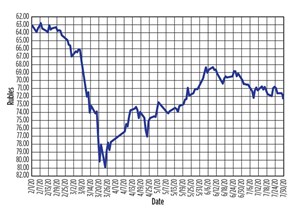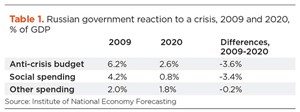Oil and Gas in the Capitals
Russia’s oil and gas sector has been rocked by two crises: the Covid-19 epidemic and the rift between Russia and Saudi Arabia, which occurred at the March 6 OPEC-Plus meeting in Vienna. This can be seen in all oil and gas producing countries. The double-crisis effects on Russia, however, were not as devastating as one might think.
The shock was significant immediately. It led to the ruble’s sharp devaluation (Fig. 1), causing import prices to rise. But, this depreciation was only temporary. The ruble exchange rate rose, as the oil price (Brent index) recovered. In fact, the extent of the crisis forced OPEC-Plus to find new ways to coordinate and restrict their production together.
The rupture was, therefore, only temporary. Production quotas are enforced more precisely, thus controls over various countries are applied more scrupulously. But, while the Russia-Saudi Arabia dispute could be overcome, this crisis had important consequences. It occurred while the global economy was locking down, following the Covid-19 outbreak. Global activity fell sharply and it is uncertain whether economic activity will regain the end-of-2019 level before 2021, or even 2022.
Looking at the hydrocarbon sector’s adjustment to the double shock, it absorbed part of the price decline. First, Russia’s well-developed infrastructure allows its oil companies to operate at low costs. Last year, big companies spent less than $4/bbl to extract oil, according to calculations based on their financial reports. Extracting oil is not all the story; you must be able to export it through transport infrastructure. So, to that $4, add about $5 for transporting a barrel and $6-8 for capital spending, and you still get a barrel of oil for less than $20.
All of this is understood for an unchanged ruble exchange rate. This was not the case, because the ruble depreciated, and this depreciation helped Russia to endure low prices. Then, consider a well-designed tax system. The tax level fluctuates, not with the crude price, but with the difference between the observed and reference prices, so that the taxes mainly relate to the oil profit margin, which constitutes the “rent” for oil companies. Russia’s hydrocarbon sector has withstood the double crisis rather well.
Russia’s hydrocarbons sector experienced a 15.5% drop in May activity (compared to May 2019), which is far from excessive. Yet the duality of the shock appears to have been less than in many other industrialized countries. GDP is only expected to fall 5.3% in 2020 and investments by 9.4%. These numbers indicate that Russia’s economy is less dependent on oil and gas production.
However, the crisis will affect growth until at least 2024. Economic growth potential, as calculated by the Institute of Forecasting, would fall to 3.4 %. Likewise, potential net investment should not grow more than 2%, per year, until 2024. Infrastructure spending may not grow more than 0.9%. Obviously, this is a problem. In fact, the disorders induced by these two crises seem to have affected the budget and financial spheres much more than that of production—good news in the short term, but bad news in the long term.
If Russia’s economic problems seem to focus on the medium term and not the short term, governmental policy is the reason. Measures taken to fight against the two crises appear weak, if we compare them to steps taken in 2009, during the financial crisis. This divergence is a real problem, especially since social spending (household support) seems to have been sacrificed.
The government will finance this effort mainly from accumulated reserves and not through issuing large sovereign debt, bought immediately by the Central Bank. If we believe the National Action Plan, which Russia adopted on May 31, the injection of money into the economy has been relatively small—around $12.3 billion.
Russian leaders have not departed from their traditional rigor. They continue to apply a relatively restrictive, austere policy. This contrasts sharply with the trend in the U.S. and Europe. Short-term results of the Russian economy allow this, but the price will be a slowdown in the economy’s medium-term transformation. Is this price not excessive? A debate on economic strategy may well erupt in the coming months.

- Management issues- Dallas Fed: Activity sees modest growth; outlook improves, but cost increases continue (October 2023)
- Executive viewpoint (April 2023)
- Global offshore market is on the upswing (April 2023)
- The last barrel (March 2023)
- Industry at a glance (February 2023)
- The last barrel (February 2023)




